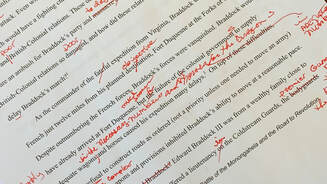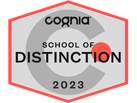IDEAVENTIONS ACADEMY
 Feedback on a student paper Feedback on a student paper About six years ago, I took my son to a summer seminar about The Lord of the Rings. What greeted me (ahem, us) were hundreds of books related to J.R.R. Tolkien. There were the books he wrote, books he read, books about the books he wrote, books about his invented languages, books about his life, books about Oxford, books about the Inklings, and many more books. It was at that moment that I wondered, “Why does my son get to have all of the fun, while I sit at the local Starbucks working while I wait for him?” Being a teacher, I knew that having an adult in a class can offset the balance of a class, but it never hurts to ask. See, I love books. I love books, shoes, and purses, in that order. I couldn’t walk out when all of these books were there and were going to be explored -- without me. After quickly figuring out that I could do the work I was supposed to work on at night, I asked my son if it was ok if I asked to sit in the class (I didn’t want to embarrass him) and when he agreed, I approached the teacher. I told the teacher that I would pay for my registration, and I promised to not say a word. I just wanted an opportunity to sit in a corner in the back of the room and learn. I promised to be a really good adult. Let’s just say that the class did not disappoint and after learning what is philology, I am now a proud owner of a 20-volume set of the Oxford English Dictionary, which I have been able to collect as libraries have sold off their copies. If you know Tolkien, you know why that is relevant. That teacher was Mr. Gardner, who is now one of our high school history teachers at Ideaventions Academy. After sitting in that Tolkien class, and the next one he taught on the Vikings, I realized that I had a gaping hole in my education. I enjoyed history when I was in middle school but did not take any history classes in college because I was afraid of taking the academic risk. The level of academic writing required in college history classes was too intimidating. I didn’t want this for our students, and we are so thankful that Mr. Gardner agreed to come and share his expertise, knowledge, and passion for history with our students. Why research-based history papers? We believe that learning how to write research papers is a multiyear process and no student shows up in high school or college knowing how to write one. It is our job as educators to expose students to long-term assignments where they are challenged to write a variety of papers, and history is a content area where they can develop the skill of writing research papers. As a math and science school with a fair number of students who aspire to be engineers, we emphasize the importance of being able to communicate both orally and in writing. As students enter high school, we invite them to challenge themselves by taking one of our intensive history classes, where they will experience the conditions to develop grit and practice perseverance. Students in this class are exposed to college and post-college level texts, learn how to pick a topic, learn how to form a thesis, learn how to read complex texts within a timeframe, and learn how to write a paper that is organized, tells a story, and uses precise language and dates. The class itself is split into two sessions - the history lesson and the writing workshop. In the history lesson, students are learning about the history that we are studying that year. The papers are done outside of class and use what they are learning in class as a way for students to figure out what area of what we’re learning about they will focus on in their paper. The writing workshop is where we work together on selecting a topic, finding books and journal articles, as well as reviewing outlines and drafts, if ready. In the writing workshop we introduce students to Turabian’s Student’s Guide to Writing College Papers, we hold technical lessons on the Chicago Manual of Style and learn how to footnote a paper. Through discussions, we also learn what goes in the body of the paper, or what is better suited for an appendix, and continue building our glossary of “vague words” that may not be used in papers turned in for this class. How do we do it? It’s a tricky dance between high standards and encouragement and support. The assignments include two short papers and a term paper each semester, and the topics include a critical book review, biographical essays, thesis-based research papers, and analytical essays. We like to give students a guided choice in determining what or who they will write about, as we have found that if a student is interested in the topic, they will be more motivated to work on their papers. The paper is the final product, and part of what we teach students through working on these long-term assignments is how to plan and manage their time by providing long-term deadlines with the scaffolding of intermediate deadlines. We break up the assignment into two intermediate deadlines, topic selection and outline, with further suggested deadlines. We also recommend dates for when a first draft should be complete, but it is a suggested date, rather than a required date. The Engineering Design Process in a History Class What I have learned in teaching students how to work through this process is that it is a process broken down into subprocesses, and this process has many similarities to the engineering design process or the scientific method, which is a description our students understand. Brainstorming: In picking a topic and researching sources, students start by brainstorming ideas for their paper. They then determine the feasibility by researching the available sources and evaluating whether the topic is too broad or too narrow. Research: The reading and research phase is probably one of the areas where the most experimentation happens in class. Some students spend substantial amounts of time reading and taking copious notes, running out of time. Others barely take notes, then have to spend hours rereading. We learn that different types of notes work for different types of topics. We have experimented with highlighting, summarizing reading sessions, taking notes on post-it notes, taking notes on note cards. It’s a messy process and yet, we learn so much. Design: Finally, students get to the point where they organize their notes into an outline. They learn that the title is more important than they realized and that everything in the outline needs to support the title and their thesis. They learn that the organization of an outline will help them tremendously when writing the paper - spend some time on the outline (design) and the implementation (writing) will be faster. Early on some students try to take shortcuts and try to write the outline while still reading based on what they think they will find. They also learn that there is a balance between an outline that is a collection of detailed notes (too detailed) and an outline that was thrown together 30 minutes before the due date (not enough detail). We also can’t forget to think about the introduction and the conclusion. Implementation: Now, we finally get to writing the paper (implementation). Many people would be happy writing that first draft, and turning it in. We ask students to work through multiple drafts and classmates who have taken the class before share techniques that they have learned. To encourage working through the process rather than the grade, we allow students to submit a rewrite of their paper and earn an A- if they weren’t happy with their first grade. Testing and Iterating: Students who take us up on the rewrite, apply the feedback that they receive, and learn from it, begin to see improvements in the next paper. The feedback they receive is extensive, and students learn that red ink is not a judgement on their writing or their worth as a person but take it as coaching and feedback meant to help them grow academically. When we explain that a teacher will only spend that much time giving feedback, it’s because he cares. In this dance of excellence and support, we also allow students to drop the lowest grade for one of the short papers. We ask students that take the intensive history courses for at least two years to compare their papers from the end of year two to the first paper they wrote. They are shocked at how much they have grown. One student said, “That first paper was embarrassing.” They also experience how much faster they become at writing papers and learn about themselves as researchers and writers. The papers are also not as scary as they were at first. I wish all students in high school had the opportunity to spend this much time learning how to research, write, and communicate. “There will come a time in most students' careers when they are assigned a research paper. Such an assignment often creates a great deal of unneeded anxiety in the student, which may result in procrastination and a feeling of confusion and inadequacy.” - Purdue Online Writing Lab Our goal is for that time to be in high school and through the support afforded at a school like ours, to avoid the feeling of inadequacy, and build a feeling of empowerment and confidence. If you want to take a look, here are papers that students wrote about The Great War and World War 2 and compiled them into a website. We're still working on sharing the writing from other topics from 2000+ years of history that we have covered in our classes. In the meantime, enjoy reading what our students have written about this particular time in history.
0 Comments
Your comment will be posted after it is approved.
Leave a Reply. |
AuthorJuliana Heitz is co-founder of Ideaventions Academy and is very excited to share the thinking behind the Academy. Archives
October 2023
Categories |
Copyright © 2010-2024| 12340 Pinecrest Road, Reston, Virginia 20191 | 703-860-0211 | [email protected] | Tax ID 27-2420631 | CEEB Code 470033
 RSS Feed
RSS Feed




